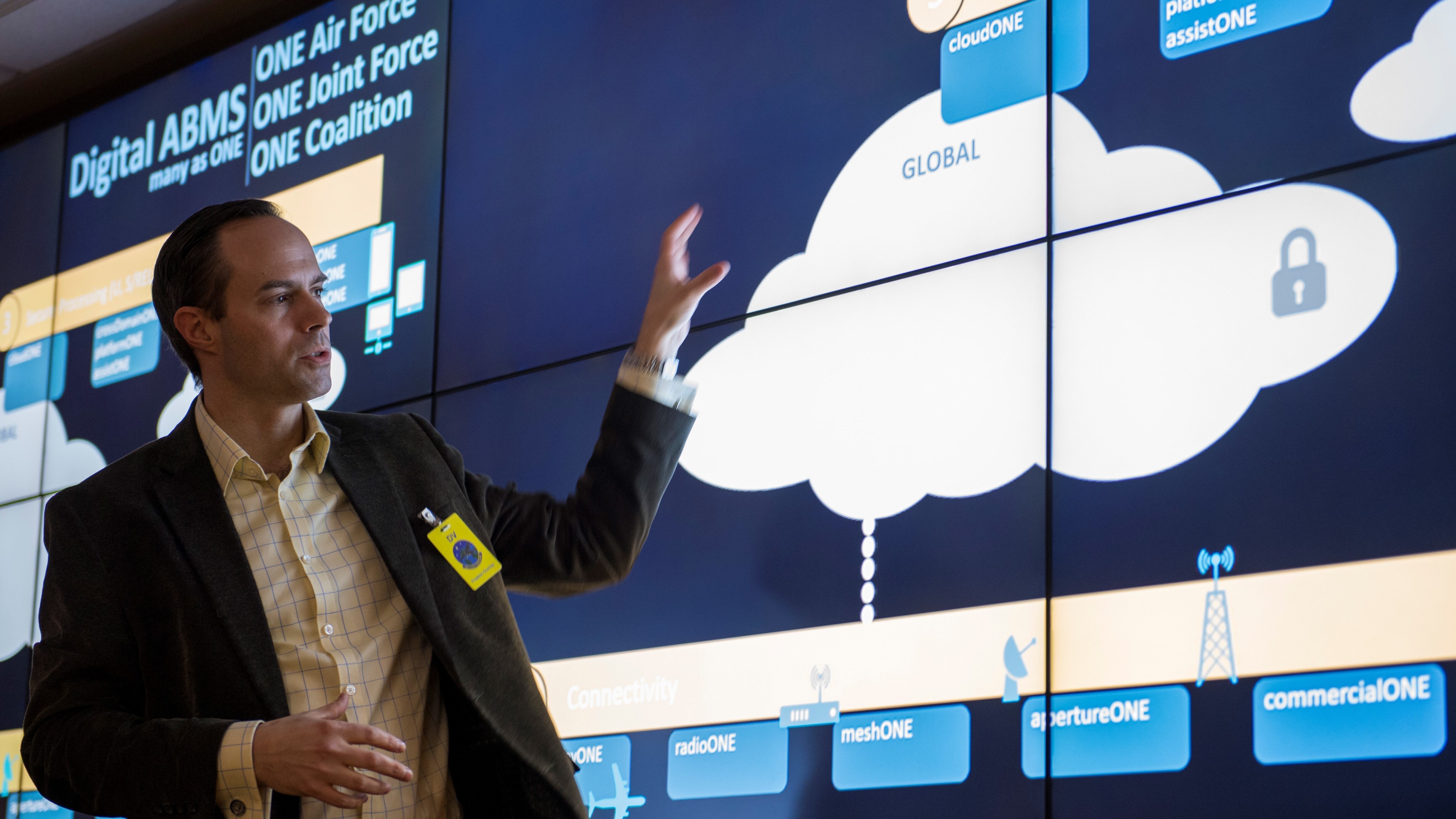
Preston Dunlap, Air Force Chief Architect, briefs Department of Defense senior leaders on how the ABMS works during the first ever ABMS live demonstration at Eglin Air Force Base, Fla., Dec. 18, 2019. (File)
WASHINGTON: As 2021 passed, the military continued its march toward digital and interconnected warfare. But a series of cyberattacks highlighted the perils that the Pentagon faces in networked warfare.
Below are the biggest network and cybersecurity stories that Breaking Defense covered for its readers this year, from cloud computing contracts to continued fallout from a 2020 hack to a ransomware attack on critical infrastructure.
[This article is one of many in a series in which Breaking Defense reporters look back on the most significant (and entertaining) news stories of 2021 and look forward to what 2022 may hold.]
Can I get, can I get a connection?
The Pentagon’s biggest initiative — or at least its most constantly talked about — was its effort to connect sensors and shooters to achieve Joint All-Domain Command and Control, an initiative guided by the Joint Chiefs of Staff. JADC2 is how the Pentagon’s envisions fighting wars in the future against a near-peer in China and Russia: a networked battlefield in which disparate systems are passing unprecedented amounts of data to help inform commanders. Each service has its own effort: the Air Force’s Advanced Battle Management System, the Army’s Project Convergence and the Navy’s vague and un-transparent Project Overmatch.
This year the military learned just how hard it is to connect previously disconnected weapons systems — culminating at the Army’s Project Convergence exercise in Yuma, Ariz. These efforts will only continue to ramp up next year as the services continue to spend big money to connect weapons systems. They talked about it a lot this year. Just look at all those links.
Pentagon invokes Order 66 and kills JEDI, hopefully ending all future Star Wars references
No year in review is complete without an in memoriam section. And in 2021, the defense contracting world lost its long-running melodrama, the Joint Enterprise Defense Infrastructure cloud effort, after the Pentagon killed the contract in the face of an endless court saga with no clear outcome in sight. After a delayed acquisition process from 2017-2019, the Pentagon awarded the single vendor, enterprise cloud contract worth up to $10 billion to Microsoft over Amazon Web Services in what was widely considered an upset. AWS almost immediately protested the award in federal court, ultimately leading the department to cancel the contract.
Out of the ashes of JEDI rose the Joint Warfighting Cloud Capability, a multi-vendor, multi-cloud enterprise contract that will, at least in theory, fulfill the department’s enterprise cloud needs. The department recently announced that it sent solicitations to Microsoft, AWS, Oracle and Google.
Colonial Pipeline hack
The ransomware attack on the Colonial Pipeline caused major disruptions and chaos up and down the East Coast, previewing of the consequences of a major cyberattack on US critical infrastructure. Experts said that the Colonial Pipeline cyberattack represented the greatest cyberattack on US critical infrastructure. The attack, carried out by a Eastern European-based cybercriminal group called DarkSide, renewed calls by experts to increase cybersecurity funding for the nation’s critical infrastructure. It also raised questions about the government and military’s role in protecting critical infrastructure.
Redefining Ransomware, Influence Ops As ‘National Security’ Threats
The aftermath of the Colonial Pipeline ransomware highlighted America’s fragility in the event that its critical infrastructure was brought down by a cyberattack. The attack also raised questions of the role of US Cyber Command’s role in responding to the attacks.
“When I was here two years ago, if someone asked me about ransomware, I would say that’s criminal activity, and the FBI handles ransomware,” CYBERCOM leader Gen. Paul Nakasone said in October. But now, “when ransomware affects critical infrastructure, it’s a national security issue.”
SolarWinds
Technically, news of a major breach of US government networks through a Texas-based IT company happened at the end of 2020, but the fallout continued throughout 2021. The SolarWinds hack, carried out by Russian intelligence as part of a cyberespionage campaign, breached both US government networks as well as contractors. The 2021 fallout saw the NSA urge industry to adopt zero-trust cybersecurity measures and increased calls for government and industry collaboration on cybersecurity. As part of the government’s response, President Joe Biden signed a wide-ranging executive order earlier this year to bolster federal cybersecurity. Microsoft warned in October that the hackers that carried out the SolarWinds operation are at it again.
Combined, the Colonial Pipeline, SolarWinds and ongoing ransomware efforts have forced the Pentagon to grapple with questions about what its role should be when it comes to protecting America in cyberspace. It’s not a question easily answered; expect the department to continue to grapple with it in 2022.






















